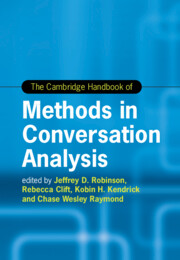Book contents
- Frontmatter
- Contents
- List of Tables
- List of Contributors
- Part I Introduction
- Part II Points of Departure
- Part III Collections
- Part IV Evidence
- Part V Avenues into Action
- Part VI Situating and Reporting Findings
- 31 Conversation Analysis across Disciplines: Connecting and Engaging through Publishing
- 32 What Do Journal Editors Look for in Publishing Conversation-Analytic Work?
- 33 Communicating Findings to Non-CA Professionals
- Part VII Looking Forward
- Appendix I Jeffersonian Transcription Conventions
- Appendix II Multimodal Transcription Conventions
- Index
33 - Communicating Findings to Non-CA Professionals
from Part VI - Situating and Reporting Findings
Published online by Cambridge University Press: 06 December 2024
- Frontmatter
- Contents
- List of Tables
- List of Contributors
- Part I Introduction
- Part II Points of Departure
- Part III Collections
- Part IV Evidence
- Part V Avenues into Action
- Part VI Situating and Reporting Findings
- 31 Conversation Analysis across Disciplines: Connecting and Engaging through Publishing
- 32 What Do Journal Editors Look for in Publishing Conversation-Analytic Work?
- 33 Communicating Findings to Non-CA Professionals
- Part VII Looking Forward
- Appendix I Jeffersonian Transcription Conventions
- Appendix II Multimodal Transcription Conventions
- Index
Summary
The growing interest in Conversation Analysis (CA) from the wider academic world, and the use of CA in contexts beyond academia, is largely due to the effective communication of CA findings. This chapter focuses on how to effectively communicate CA findings to non-CA professionals, such as healthcare professionals, academics, teachers, the police, politicians, and beyond. When training professionals in CA findings, careful considerations need to be made to make our findings welcome, whilst at the same time preserving the detail and nuances of human interaction. Decisions about the selection and length of representative extracts, together with decisions about the central messages being conveyed, require careful consideration. Challenges and tensions can arise when making these decisions including, managing the issue of (a) the professionals’ expertise, (b) avoiding negative self- and other evaluations, (c) how to present the data without getting lost in the detail; and (d) addressing concerns about generalizability and quantification. This chapter will address these possible tensions and offer guidance and practical solutions regarding the decisions that are made to effectively train non-CA professionals.
Keywords
- Type
- Chapter
- Information
- The Cambridge Handbook of Methods in Conversation Analysis , pp. 928 - 940Publisher: Cambridge University PressPrint publication year: 2024

